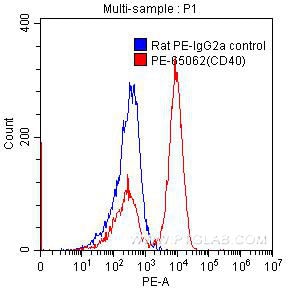Anticorps Monoclonal anti-CD40
CD40 Monoclonal Antibody for FC
Hôte / Isotype
Rat / IgG2a, kappa
Réactivité testée
souris
Applications
FC
Conjugaison
PE Fluorescent Dye
CloneNo.
1C10
N° de cat : PE-65062
Synonymes
Galerie de données de validation
Applications testées
| Résultats positifs en cytométrie | splénocytes de souris |
Dilution recommandée
| Application | Dilution |
|---|---|
| This reagent has been tested for flow cytometric analysis. It is recommended that this reagent should be titrated in each testing system to obtain optimal results. | |
| Sample-dependent, check data in validation data gallery | |
Informations sur le produit
PE-65062 cible CD40 dans les applications de FC et montre une réactivité avec des échantillons souris
| Réactivité | souris |
| Hôte / Isotype | Rat / IgG2a, kappa |
| Clonalité | Monoclonal |
| Type | Anticorps |
| Immunogène | sCD40 |
| Nom complet | CD40 antigen |
| Numéro d’acquisition GenBank | BC029254 |
| Symbole du gène | Cd40 |
| Identification du gène (NCBI) | 21939 |
| Conjugaison | PE Fluorescent Dye |
| Excitation/Emission maxima wavelengths | 496 nm, 565 nm / 578 nm |
| Forme | Liquide |
| Méthode de purification | Purification par affinité |
| Tampon de stockage | PBS avec azoture de sodium à 0,1 % et un agent stabilisant. |
| Conditions de stockage | Store at 2-8°C. Avoid exposure to light. Stable for one year after shipment. |
Informations générales
CD40, also named as TNFRSF5 and Bp50, is a type I transmembrane protein that belongs to the tumor necrosis factor-R (TNF-R) family (PMID: 10647992). CD40 is expressed on B cells, dendritic cells (DCs), monocytes, platelets, and macrophages as well as by non-hematopoietic cells such as myofibroblasts, fibroblasts, epithelial, and endothelial cells (PMID: 19426221). It is a receptor for TNFSF5/CD40LG. CD40L/CD40 interactions are essential for immunoglobulin (Ig) isotype switching, germinal center formation and the development of B cell memory (PMID: 7516405; 11675497).
Protocole
| Product Specific Protocols | |
|---|---|
| FC protocol for PE CD40 antibody PE-65062 | Download protocol |
| Standard Protocols | |
|---|---|
| Click here to view our Standard Protocols |


